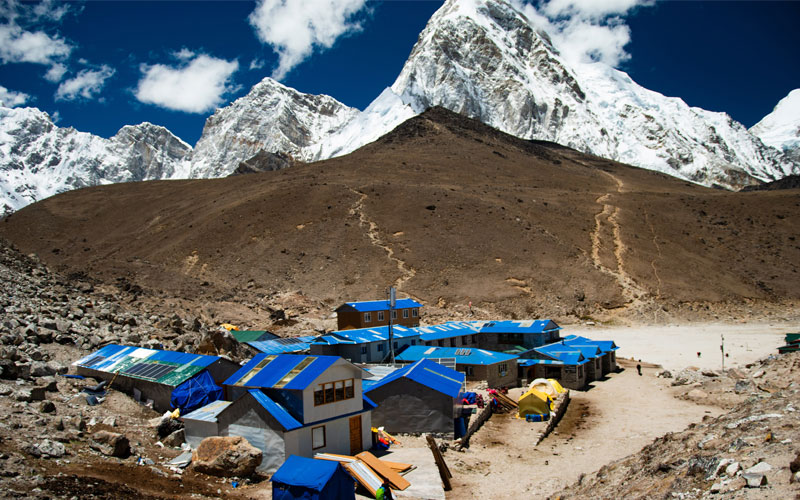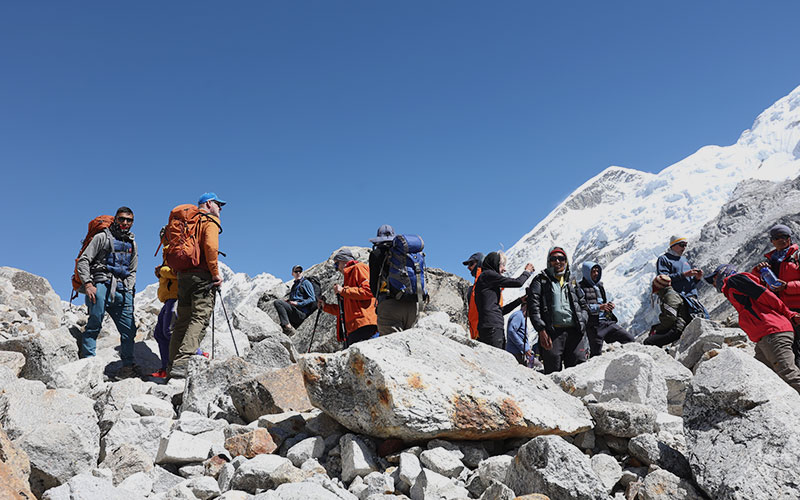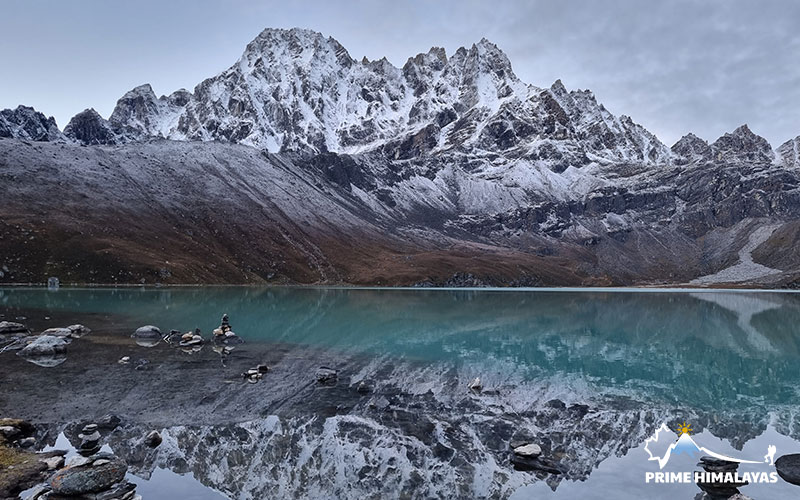The highest part of the Himalayas region of Nepal is best known for its freezing weather. However, there are certain times during the year when the weather is sunny and bright and trekking during those times automatically means winning over Everest Base Camp trek difficulties. Mainly, there are two popular trekking seasons – Autumn (September, October, and November) and Spring (March, April, and May), which are also often regarded as best seasons for trekking to Everest Base Camp.
Despite having two major seasons, it is not a compulsion for you to undertake trekking within these seasons because picking the best time for trekking totally depends upon your preferences. For example, if you want to see Everest Base Camp filled with tents, trekkers, and climbers, then as listed above; high-seasons like autumn and spring are best for you. However, if you want to avoid the hustle and bustle of trekkers and tents around the camp, then off-season for EBC i.e., winter (December, January, and February) is best for you.
Below, we have listed out the important points regarding timing for the trek so that you can easily pick the best time for your Everest Base Camp trek.
Everest Base Camp Weather
Everest Base Camp weather is one of the extremes. It is located at an extremely high altitude of 5,380m which results in unpredictable weather changes. So, you can say that the land of Everest region is never really ‘warm’. However, the level of coldness, precipitation, snowfall, and temperature keeps changing throughout the year because of which it is essential for you to pick the best weather as a part of your preparation and training for Everest Base Camp Trek.
| Months | Temperature (°C) | Wind Speed (Km/hr.) | Sunshine (Per Day) | Precipitation (MM) |
| January | -17 to 4 | 12 – 19 | 5 – 7 | 20 |
| February | -15 to 4 | 12 – 19 | 6 – 7 | 25 |
| March | -12 to 7 | 15 | 7 | 25 |
| April | -5 to 10 | 14 | 7 | 40 |
| May | 0 to 15 | 15 | 8 – 9 | 50 |
| June | 5 to 17 | 16 | 11 | 170 |
| July | 8 to 16 | 16 | 6 – 7 | 260 |
| August | 6 to 16 | 16 | 6 – 7 | 250 |
| September | 2 to 17 | 8 – 11 | 8 | 130 |
| October | -7 to 12 | 8 – 11 | 6 – 7 | 50 |
| November | -12 to 7 | 8 – 11 | 6 – 7 | 10 |
| December | -15 to 4 | 19 | 5 – 7 | 10 |
Above mentioned weather chart of Everest Base Camp represents average data which keeps on fluctuating every year. You can’t expect exactly same weather as the weather in the Himalayas region of Nepal is unpredictable as a result sometimes it is extremely cold and sometimes it seems bearable. However, the fluctuation rate is nearer to above presented data.
Everest Base Camp Season
Usually, Everest Base Camp has similar seasons as other regions of Nepal. Below, we have explained about the four major seasons that can be found in the Everest region.
1. Spring Season (March – May)
March, April, and May fall under spring season and are regarded as the best months for trekking in Everest Base Camp. The reasons behind the hype of these months are stabilization of weather, clear views, little or no rainfall, no problematic snowfall, average temperature etc. Besides these, the blooming red and pink rhododendrons throughout the trail and a greater number of sunny days during this season automatically attract a lot of trekkers.
However, as a part of the drawbacks, trekking in spring season can be opposite of your needs because of the crowded routes, hard to get access to the porter and guide, excessive cost, and lack of easy access to lodges and teahouses. So, if you want to get the best out of your trek, then these are trade-offs which you need to make.
2. Autumn Season (September – November)
September, October, and November are other equally popular months to trek Everest Base Camp. Like spring, autumn is also one of the seasons when trekkers’ rate automatically increases. The reasons behind this are because of the great visibility, clear far views, pleasant day time temperature, stable weather etc. Autumn season also has its own drawbacks like difficult to find local porter and guide, less access to accommodation, crowded base camp with trekkers, climbers and tents, excessive cost for every facility etc.

Autumn and spring fall in high season as a result the arisen of problems like difficult to find porters and guides, and accommodation is not so surprising. However, solo trek to Everest Base Camp during these seasons can affect your whole trip. So, to avoid the drawbacks of these seasons and to enjoy hassle free trekking, remember to plan your trip with us, Prime Himalayas, as we will provide you with the experienced local guide and porter for the Everest Base Camp Trek by booking for the accommodation in advance.
3. Winter Season (December – February)
Winter Season (December, January, and February) is not a bad season, instead it is regarded as the off-season. The only drawbacks that come with this season is extreme freezing temperature and high snowfall because of which trekking during this time is mostly avoided. However, if you are ready to deal with cold, then you will be rewarded with excellent views because of clear skies.
Also, you don’t need to trek along the crowded route by jostling for space and access to porters, guide, and accommodation is also easy. However, sometimes because of problematic snowfall, teahouses remain closed. So, book for the accommodation in advance for your trip by getting in touch with the local Trekking agency in Nepal.
If you are planning to trek in winter, then remember to layer the clothing and don’t miss the important packing list for Everest Base Camp as you need to remain warm to avoid the adverse consequences.
4. Summer/Monsoon Season (June – August)
Summer season (June, July, and August), also known as monsoon season, is not an ideal time to visit Everest Base Camp. During this time, there is heavy rainfall which might raise the possibility of landslide and muddy trails. Also, the views are often blocked by the rain clouds. In addition to these, you also need to prepare yourself for the delay in flights as Lukla flights are often cancelled because of rain, smog, and fog. However, the temperature is warm during this time.
So, if you don’t mind taking the risk of flight delays and want to enjoy scenic views, you can consider these months for trekking. However, we don’t recommend planning your trip during this season as it decreases the chance of your success rate.

Peak Season Crowds
Spring and autumn seasons are overcrowded with a lot of visitors. As a result, you need to struggle a lot to find the decent and well-managed accommodation along with guide and porter. So, trekking Everest Base Camp with a guide is the best option if you want to avoid the problems and just enjoy the panorama of the surroundings. Also, peak season crowds will affect a lot in your Lukla flight as tickets will be booked in advance by other trekkers.
So, remember to plan your trip with us, Prime Himalayas, for this trek as we will help you to manage all the Everest Base Camp difficulties by providing the experienced guide and porter and taking care of the booking in advance.
Alternate Routes to Everest Base Camp
Peak seasons (spring and autumn) are the best times to trek Everest Base Camp because of the favorable climatic situation; however, busy trails may confuse you to either go for these seasons or not. So, to deal with this problem, an alternative route to Everest Base Camp is the only way as it takes you to the base camp through an isolated part of the Himalayas. You can break away from the crowd even during peak seasons by choosing the quieter trail and can discover the unexplored beauty of Everest region.
Gokyo Lake Trek, Three Passes Trek etc. are the other best alternatives to EBC trek that takes you to the foot of Mt. Everest through the empty trail even during high seasons. It is best for you to choose these routes, if you want to avoid the crowd and still want to enjoy the life of Himalayan people.

There are several different routes to choose besides classic EBC trails. You can go for an overland journey as an alternative to flying to Lukla from Kathmandu. You have a lot of options available for overland trip. Most popular one being drive to Salleri from Kathmandu (8-9 hrs.) and start your trek to Phakding, which takes around 4 days. Also, drive from Kathmandu to Jiri is another option for you.
From Jiri, you can trek all the way to Lukla and can avoid the busy flights. Similarly, you can also fly to Phaplu from Kathmandu and trek to the end of Solukhumbu from there. It might increase your itinerary, but it will make your journey wonderful even during high seasons.
Festive Season on Everest Region
Best time to visit Everest Base Camp is also affected a lot by the festive season. Most of the travelers visit Nepal to witness the traditional festivals of Hindu and Buddhist and to be a part of it. Everest region is inhabited by Tibetan Buddhist Sherpa people and their culture and traditions are totally different from the one of Kathmandu valley.
One of the important and grand festivals of Sherpa people is Mani Rimdu which is celebrated either in October or November. During this festival, the environment of Everest region, mainly Tengboche Monastery, is worth watching as one can see the monks clad in their traditional dresses, locals following their customary rituals and performing ritual dances.
So, if you are someone who is extremely interested in knowing about the culture and lifestyle of people, then October/November is the best month for you to trek Everest Base Camp.
Conclusion
Everest Base Camp weather is notoriously unpredictable; however, this is one of the adventurous things about this trek. There is not any tough time for this trek as you can accomplish the trek throughout the year with the proper packing list and right preparations and training for Everest Base Camp trek. Besides a lot of challenges, all you need to focus is on mental preparation and your physical fitness.
If you need any further information about the best time for Everest Base Camp trek, then feel free to contact us. We love to assist you throughout the journey to provide you hustle-free trekking in one of the wonders of Nepal – Everest Base Camp.
